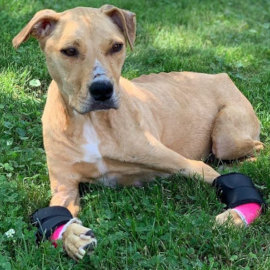Carpal Hyperextension in Dogs
By admin / February 10, 2023 / No Comments / Uncategorized
What is a Carpal Hyperextension?

Hyperextension of the carpal is a joint condition that involves the supportive ligaments or soft tissue in the forelimb and wrist of the dog.
Hyperextension is the excessive joint movement where the angle formed by the bones of a particular joint is opened or straightened beyond its normal, healthy range of motion. When a dog or cat’s carpus is overstretched it causes the joint to drop towards the floor. This condition is painful and can cause significant changes to how the pet walks on it’s front legs.
What Are the Causes of Carpal Hyperextension?
There are 3 main causes of carpal hyperextension, congenital carpal deformity, traumatic injury, and degenerative hyperextension.
Congenital Deformity
Congenital carpal hyperextension happens when the ligaments in your puppy’s carpal (wrist) joint don’t develop full strength as your puppy grows. Sometimes referred to as Carpal Laxity Syndrome, with this condition typically the dog will have a malformation of the ligaments in both front legs. In the most severe cases, the dog’s carpal and wrist may even touch the ground when the puppy walks.
Trauma
Traumatic injury is the most common cause of canine carpal hypertension. Hyperextension can be caused by excessive force on the carpal, where the dog’s joint bends more than it should and overstretches the joint. This leads to tearing of the ligaments and fibrocartilage on the back of the forelimb, causing the carpal joint’s collapse. This often occurs after a fall and injuries while exercising and playing.
Degenerative
While it is less common, carpal hyperextension can occur in dogs with immune-mediated joint disease or degenerative conditions of the ligaments. Hyperextension due to joint degeneration is most common among the Collie breed and senior dogs. In older dogs with degenerative carpal hyperextension, the lower front leg will slowly lower to the ground as the condition worsens.
The Symptoms of a Hyperextended Carpal

Generally, hyperextension injuries are seen in large active dogs, but small breeds can still suffer from a hyperextension injury. Signs of carpal hyperextension are easy to spot, and they typically begin with a gait abnormality and noticeable limping.
- Limping on the front leg
- Swelling at the carpal joint or wrist
- Pet’s wrist has “dropped”, when the lower front leg sinks towards ground
However, if your dog starts to exhibit limping and refuses to put weight on the injured wrist, or there is visible swelling of the carpal, and the sinking of their paw to the ground while moving around, you should make an appointment with your veterinarian to discuss a carpal hyperextension injury.
Carpal Hyperextension Diagnosis
Carpal hyperextension is typically diagnosed by a veterinarian specializing in orthopedics. A dog will be evaluated through a series of assessments, including an X-ray and monitoring how it walks and bears weight on its front leg. A CT or MRI may also be necessary, especially if bones in the pet’s front legs are broken. For more minor hyperextensions, the dog or cat may need to be anesthetized for a thorough examination.
How is Carpal Hyperextension Treated?
Carpal hyperextension can be treated through conservative management and also surgery. However, the proper treatment for your pet will depend on the severity of the hyperextension.
Surgery
For more severe cases, surgery may be the best option. Your veterinarian or orthopedic specialist will help you decide what is the best option for your cat or dog. Pan-carpal arthrodesis is a surgical procedure that completes fuses the carpal joints to the paw with plates and screws. The steel plate covers the entire joint, wrist, and the radius to fuse the leg into a natural position. Recovery from this surgery usually includes many weeks of physical therapy.
Conservative Management with Splinting and Physical Therapy
A conservative approach that includes physical therapy and splinting can benefit less severe cases. For example, a hard splint that braces the carpal joint can be used to stabilize the hyperextension. There are two splint styles to support the carpal, A neoprene wrist wrap can also be used in minor issues where only light support is needed. At the same time, your dog undergoes rehabilitation, whether that be through hydrotherapy, structured exercises with physical therapy, or just their everyday walks and play!

